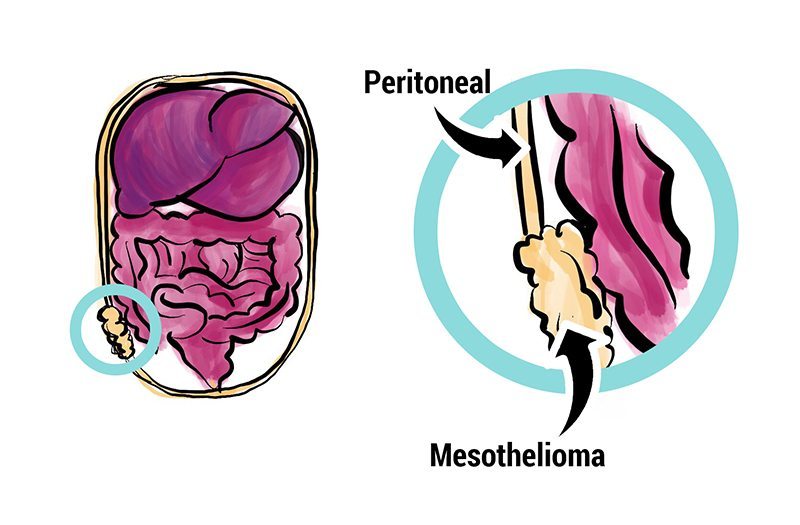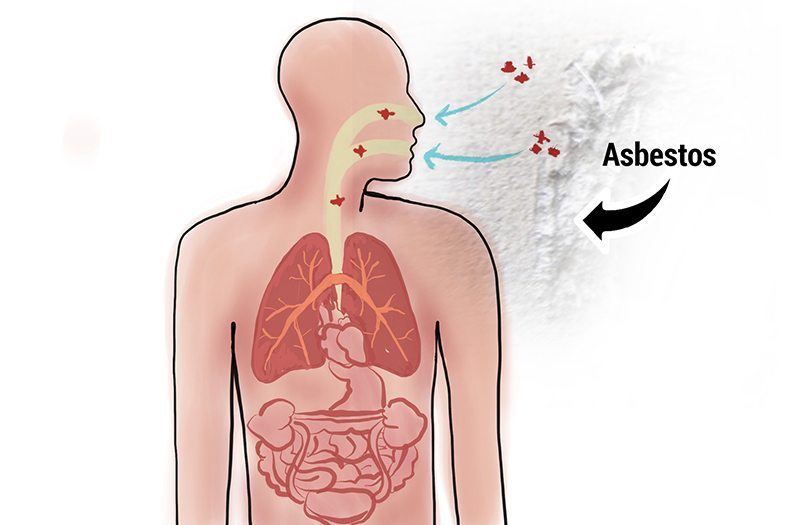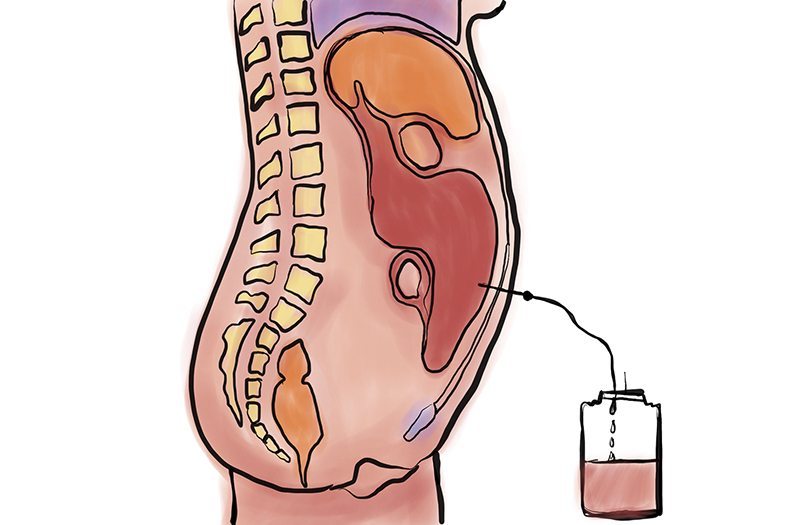What is Peritoneal Mesothelioma?

Malignant peritoneal mesothelioma, also referred to as abdominal mesothelioma, is a deadly cancer found in the tissue that lines the abdomen and surrounds the abdominal organs.
It accounts for anywhere from 20 to 33 percent of mesothelioma cases, according to research published in the Medscape General Medicine journal, making it the second-most common type of mesothelioma behind pleural mesothelioma. Other cases are pericardial and testicular mesothelioma.
Unfortunately, there is no cure for peritoneal mesothelioma, but treatment options are available to reduce patients’ pain and possibly extend their lives.
Cause of Peritoneal Mesothelioma
The only known cause of this cancer is exposure to asbestos.
The Occupational Safety & Health Administration reports that common household and industrial building products contain asbestos, including:
- Pumps, Valves, Boilers and Turbines
- Roofing and siding
- Floor tiles
- Plaster, cement, putty and caulk
- Ceiling tiles spray-on coatings
- Insulation
- Gaskets and Packing
- Lab Equipment
People whose work exposed them to asbestos are most at risk of developing peritoneal mesothelioma.
Veterans, construction workers, industrial workers, mechanics and shipbuilders in New York and throughout the United States make up the majority of cases.
It is important to note, though, that asbestos has also been shown to cause mesothelioma in family members of these workers and others with limited exposure because microscopic asbestos fibers can be transferred from clothing or uniforms.

Although asbestos has been definitively identified as the cause of peritoneal and other types of mesothelioma, it is still not completely banned in the United States.
In fact, throughout New York City, New York State and the Tri-state area, exposure to asbestos is still a real threat.
Peritoneal Mesothelioma Development
When people directly handle materials that contain asbestos — or work in an area where materials that contain asbestos are being worked on — they can be exposed to microscopic asbestos fibers.
In most cases, these fibers are inhaled, which can result in the most common form of the cancer – pleural mesothelioma. However, these asbestos fibers can also be swallowed and lodge in the peritoneum tissue that lines the abdominal cavity, the organs in it and lymph nodes.
When asbestos fibers are ingested, they can get stuck in the abdomen and stay in the body for years before showing signs of irritation and eventually peritoneal mesothelioma.
Experts warn that it can take 15 to 60 years for it to develop, meaning most victims are older people who were exposed to asbestos decades ago.
Symptoms of Peritoneal Mesothelioma
Symptoms can often be confused with symptoms from other abdominal illnesses or diseases. Most people suffering from peritoneal mesothelioma initially experience:
- Abdominal pain or swelling
- Ascites (a build-up of fluid in the abdominal area)
- Lumps of in the abdomen
- Weight loss
- Fever
Because symptoms can mimic other problems, it may take months for a patient to receive a proper diagnosis.
In that time, the disease can spread aggressively, leaving the patient with fewer treatment options.
Therefore, if you or a loved one is experiencing these types of symptoms and may have been exposed to asbestos, discuss this with your physician immediately.
Peritoneal Mesothelioma Diagnosis
The doctor typically starts with a physical exam and asks about a patient’s history. It is important for patients to tell their mesothelioma doctors if they have been exposed to asbestos. The sooner a peritoneal mesothelioma diagnosis can be made, the better.

Typically, physicians will order these tests to make a peritoneal mesothelioma diagnosis:
- X-ray, CT scan or MRI: These diagnostic imaging tests can help identify tumors and the cancer’s location. However, they are not detailed enough to diagnosis the cancer as peritoneal mesothelioma.
- Fine needle aspiration: A very small needle is used to collect fluid and tissue from the abdomen, which is then tested for abnormalities and signs of cancer.
- Biopsy: Doctors will need to take tissue samples with a biopsy to make a peritoneal mesothelioma diagnosis.This can be done through a peritoneoscopy, where the abdominal wall is cut and a thin, tube-like instrument with a light and camera is inserted into the abdomen. It can also be done through a laparotomy, where a physician makes an incision in the wall of the abdomen to look for signs of the cancer.
Peritoneal Mesothelioma Treatment Options
Because many peritoneal mesothelioma patients do not receive a diagnosis until the cancer is in the advanced staging system, most peritoneal mesothelioma treatment is palliative (aimed at relieving pain and making the person comfortable), rather than curative (aimed at killing the cancer cells and preventing cell growth).
For patients healthy enough to undergo surgery, peritoneal mesothelioma treatment may consist of cytoreduction surgery combined with heated chemotherapy:
Peritoneal Mesothelioma Cytoreduction Surgery
Also known as debulking, cytoreduction surgery aims to remove all visible cancer from the peritoneal cavity.
This can be complicated, as the cancer may have spread to the omentum (a sheet of fat in the abdomen) and organs such as the spleen, pancreas, intestines, liver, colon, uterus, ovaries, stomach, bladder and gallbladder.
Peritoneal Mesothelioma Heated Intraoperative Chemotherapy (HIPEC)
While the patient is in surgery, doctors can administer heated chemotherapy directly to the abdominal area, a treatment that can be more effective than traditional chemotherapy.
In addition, patients may opt for radiation, medication or clinical trials as treatments for peritoneal mesothelioma.
Prognosis & Life Expectancy for Patients with Peritoneal Mesothelioma
Approximately 200 to 400 people are diagnosed with peritoneal mesothelioma each year in New York and throughout the United States, according to a report in the Medscape General Medicine journal.
The American Cancer Society estimates the median survival time can range from 12 to 21 months, depending on how early the cancer is diagnosed. A peritoneal mesothelioma prognosis will also depend on the patient’s health, age, gender and the type of cancer cells detected.
If you are facing a peritoneal mesothelioma diagnosis, be aware that there is a support community of mesothelioma specialists, nurses, patients, caregivers and advocates here to help you and your loved ones through your journey.
Sources & Author:
- American Cancer Society: Survival Statistics for Mesothelioma
http://www.cancer.org/cancer/malignantmesothelioma/detailedguide/malignant-mesothelioma-survival-statistics - Cancer Research UK: What mesothelioma is
http://www.cancerresearchuk.org/about-cancer/type/mesothelioma/about/what-mesothelioma-is - Medscape General Medicine: Peritoneal Mesothelioma: A Review
https://www.ncbi.nlm.nih.gov/pmc/articles/PMC1994863/ - Mesothelioma Applied Research Foundation: About Peritoneal Mesothelioma
http://www.curemeso.org/site/c.duIWJfNQKiL8G/b.8578883/k.931C/Types_of_Mesothelioma__Peritoneal_Mesothelioma.htm - National Cancer Institute: Malignant Mesothelioma Treatment (PDQ®)
